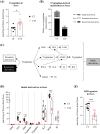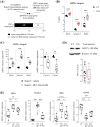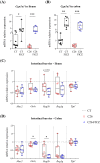Impairment of aryl hydrocarbon receptor signalling promotes hepatic disorders in cancer cachexia
- PMID: 37127348
- PMCID: PMC10235873
- DOI: 10.1002/jcsm.13246
Impairment of aryl hydrocarbon receptor signalling promotes hepatic disorders in cancer cachexia
Abstract
Background: The aryl hydrocarbon receptor (AHR) is expressed in the intestine and liver, where it has pleiotropic functions and target genes. This study aims to explore the potential implication of AHR in cancer cachexia, an inflammatory and metabolic syndrome contributing to cancer death. Specifically, we tested the hypothesis that targeting AHR can alleviate cachectic features, particularly through the gut-liver axis.
Methods: AHR pathways were explored in multiple tissues from four experimental mouse models of cancer cachexia (C26, BaF3, MC38 and APCMin/+ ) and from non-cachectic mice (sham-injected mice and non-cachexia-inducing [NC26] tumour-bearing mice), as well as in liver biopsies from cancer patients. Cachectic mice were treated with an AHR agonist (6-formylindolo(3,2-b)carbazole [FICZ]) or an antibody neutralizing interleukin-6 (IL-6). Key mechanisms were validated in vitro on HepG2 cells.
Results: AHR activation, reflected by the expression of Cyp1a1 and Cyp1a2, two major AHR target genes, was deeply reduced in all models (C26 and BaF3, P < 0.001; MC38 and APCMin/+ , P < 0.05) independently of anorexia. This reduction occurred early in the liver (P < 0.001; before the onset of cachexia), compared to the ileum and skeletal muscle (P < 0.01; pre-cachexia stage), and was intrinsically related to cachexia (C26 vs. NC26, P < 0.001). We demonstrate a differential modulation of AHR activation in the liver (through the IL-6/hypoxia-inducing factor 1α pathway) compared to the ileum (attributed to the decreased levels of indolic AHR ligands, P < 0.001), and the muscle. In cachectic mice, FICZ treatment reduced hepatic inflammation: expression of cytokines (Ccl2, P = 0.005; Cxcl2, P = 0.018; Il1b, P = 0.088) with similar trends at the protein levels, expression of genes involved in the acute-phase response (Apcs, P = 0.040; Saa1, P = 0.002; Saa2, P = 0.039; Alb, P = 0.003), macrophage activation (Cd68, P = 0.038) and extracellular matrix remodelling (Fga, P = 0.008; Pcolce, P = 0.025; Timp1, P = 0.003). We observed a decrease in blood glucose in cachectic mice (P < 0.0001), which was also improved by FICZ treatment (P = 0.026) through hepatic transcriptional promotion of a key marker of gluconeogenesis, namely, G6pc (C26 vs. C26 + FICZ, P = 0.029). Strikingly, these benefits on glycaemic disorders occurred independently of an amelioration of the gut barrier dysfunction. In cancer patients, the hepatic expression of G6pc was correlated to Cyp1a1 (Spearman's ρ = 0.52, P = 0.089) and Cyp1a2 (Spearman's ρ = 0.67, P = 0.020).
Conclusions: With this set of studies, we demonstrate that impairment of AHR signalling contributes to hepatic inflammatory and metabolic disorders characterizing cancer cachexia, paving the way for innovative therapeutic strategies in this context.
Keywords: CYP1A1; CYP1A2; HIF1α; TIPARP; fibroblast growth factor 21.
© 2023 The Authors. Journal of Cachexia, Sarcopenia and Muscle published by John Wiley & Sons Ltd on behalf of Society on Sarcopenia, Cachexia and Wasting Disorders.
Conflict of interest statement
The authors declare that the research was conducted in the absence of any commercial or financial relationships that could be construed as a potential conflict of interest.
Figures






References
-
- Roman ÁC, Carvajal‐Gonzalez JM, Merino JM, Mulero‐Navarro S, Fernández‐Salguero PM. The aryl hydrocarbon receptor in the crossroad of signalling networks with therapeutic value. Pharmacol Ther 2018;185:50–63. - PubMed
-
- Hankinson O. The aryl hydrocarbon receptor complex. Annu Rev Pharmacol Toxicol 1995;35:307–340. - PubMed
Publication types
MeSH terms
Substances
Grants and funding
LinkOut - more resources
Full Text Sources
Medical
Research Materials
Miscellaneous

